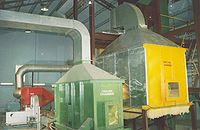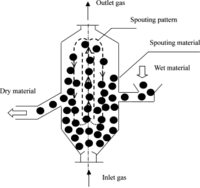Difference between revisions of "Spouted Bed Dryers"
m |
|||
| Line 1: | Line 1: | ||
[[Category:Drying]]{{Knoppen}} | [[Category:Drying]]{{Knoppen}} | ||
[[File:Spouted Bed Dryers.jpg|thumb|200px|right|Spouted Bed Dryers]] | [[File:Spouted Bed Dryers.jpg|thumb|200px|right|Spouted Bed Dryers]] | ||
[[File:Spouted_Bed_Dryers_schematic. | [[File:Spouted_Bed_Dryers_schematic.gif|thumb|200px|right|Spouted Bed Dryer schematic]] | ||
'''Spouted Bed Dryers''' introduced an improved drying technique for groundnuts in an attempt to reduce post-harvest losses in quality and quantity. The applicability or the spouted bed technique to drying of granular products that are too coarse to be readily fluidized (e.g. grains) was reconized in the early 1950s | '''Spouted Bed Dryers''' introduced an improved drying technique for groundnuts in an attempt to reduce post-harvest losses in quality and quantity. The applicability or the spouted bed technique to drying of granular products that are too coarse to be readily fluidized (e.g. grains) was reconized in the early 1950s | ||
Latest revision as of 02:35, 30 April 2013
Spouted Bed Dryers introduced an improved drying technique for groundnuts in an attempt to reduce post-harvest losses in quality and quantity. The applicability or the spouted bed technique to drying of granular products that are too coarse to be readily fluidized (e.g. grains) was reconized in the early 1950s
Comparison between Fluidized Bed and Spouted Bed Drying
Fluidized bed dryers (FBDs) and spouted bed dryers (SBDs) are considered efficient dryers for drying seeds from high moisture content (MC; 20–25%wb) to medium MC (≈18%wb). In this work, a number of drying experiments and seed quality tests were conducted using rice and wheat seeds in order to compare the FBD and SBD with regard to drying rate, product quality, and specific energy consumption. It was found that FBD was better in terms of a faster drying rate and SBD was better in terms of specific energy consumption. However, it could not be clearly concluded which dryer provided a better product quality in terms of germination percentage.
Drying characteristics in a jet-spouted bed dryer
A conical jet-spouted bed dryer with inert bodies was used for drying of animal blood plasma. The effects of the operating conditions on the product properties, final moisture content and throughput of the dryer were investigated. A drying rate model using the conventional rate equation, where the overall effective driving force is based on the surface temperature calculated from the unsteady-state heat transfer Fourier equation, was proposed. Satisfactory agreement between calculated and experimental results was obtained.

